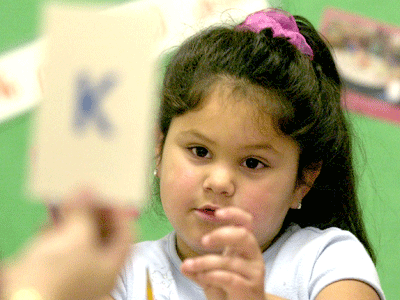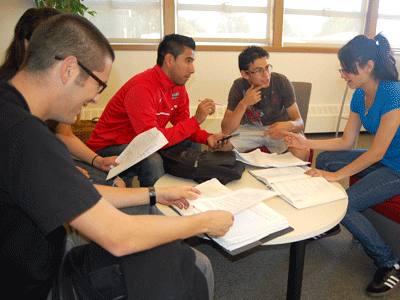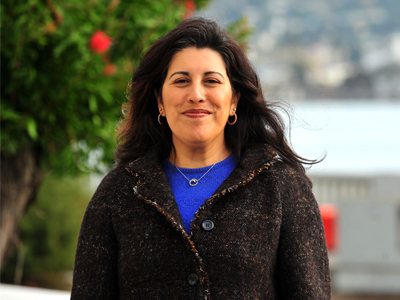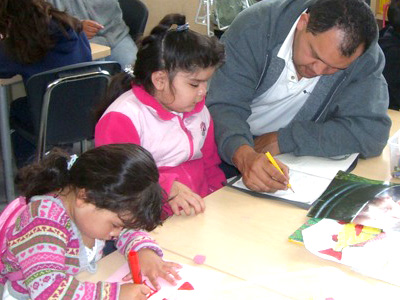
Teaching methods, school demographics, parental involvement determine success or failure ---
The end of the school day in Patty Sanchez’s kindergarten class at Geddes Elementary School is not so different from other kindergarten classes around the state. Children gather on a rug as Sanchez holds up a storybook about a coyote and a turtle and reads out loud.
What’s different is that Sanchez is reading in Spanish.
Nearly all of the children in the room are Hispanic, and many are English-language learners. The few who are new to Spanish are expected to follow along with the story, too, and respond in Spanish to Sanchez’s questions.
Halfway through the story, she asks one little boy, a native English speaker, “¿Por qué está llorando la tortuga?” and quiets the children sitting nearby who try to whisper hints.
When he struggles with an answer, she gives him a prompt: Is the turtle triste – sad – or feliz – happy?
Finally, he gets it. “Triste!” he says.
The scene highlights a continuing California debate: More than a decade after voters approved an initiative to limit bilingual education in public schools, the state is using a hodgepodge of programs. Meanwhile, critics contend, young students pay the price.
Educators cannot agree on the best way to teach English to non-native speakers. Success is anecdotal. Studies appear to contradict each other. Meanwhile, the percentage of California English learners who are proficient in fourth-grade English has dropped on a national test.
The dual-language program at Geddes, where children are taught in Spanish 90 percent of the day until third grade, is a relative rarity in California these days. Since 1998, when voters passed Proposition 227, limiting the use of bilingual education, the number of English learners being taught in their primary language has dropped by half.
At the same time, the number of English learners has grown to about 1.5 million – about a quarter of California’s student population. Nearly 85 percent of them are Spanish speakers.
Proponents of Prop. 227 say English immersion is essential to students learning the language as quickly as possible, pointing to increases in academic performance by English learners on state tests since the law passed. About a third of English learners scored proficient or above on the state tests in fourth grade last year, more than double the percentage who were proficient in 2003.
“All the supporters of bilingual education said it would be a total disaster when it passed,” said Ron Unz, who led the movement for Prop. 227. “After the initiative passed, there was a lot of resistance. But within a couple of years, the tests came out. Everyone switched around.”
Bilingual education in California never worked, said Linda Espinosa, a former principal in a bilingual school in California and a University of Missouri-Columbia researcher who now works as a consultant for the California Department of Education. “The children never became proficient in English, and they tended to lose their home language,” she said.
But the English immersion system is not working either, she said.
Some students still learn in bilingual settings, where they gradually transition from their home language to English, while most others are immersed in English right away, usually with the help of specialized programs that help them learn English. A few schools have veered from both approaches and adopted dual-language programs, in which half the students are native English speakers and half are native Spanish speakers.
Patricia Gandara, an educational psychologist at UCLA, said students in bilingual programs often go to schools with higher concentrations of poverty, which is linked to lower test scores. She also said bilingual education programs have struggled because of a reduction in the number of qualified bilingual educators in California. In 2006, 556 teachers were certified to teach bilingual education, compared with 440 last year.
Increasing the involvement of immigrant parents in their children’s education, particularly early on, is also critical, school leaders and experts say. For parents who don’t speak English and have a low level of education themselves, helping with homework and advocating for their children can be difficult. But Gandara says connecting a child’s home life with school is the linchpin to success.
“The issue around bilingual instruction for me is, most importantly, having teachers in the classroom who can communicate with the parents and get parents to help them,” Gandara said. “Teachers who can talk to parents, can gain the trust of the parents – we don’t have that by and large in California.”
Manzanita SEED Elementary School in Oakland is another bilingual school that has closed the achievement gap. Last year, it was one of only two schools in California to receive federal recognition as a Title I Distinguished School for its high test scores.
Manzanita’s principal, Katherine Carter, helped open the school in 2005. On the wall of her office, she keeps a display with photos of every student in the school, categorized by their test scores. The school also has implemented an expeditionary learning model, in which students do major projects as a part of the curriculum and standards are emphasized.
Researchers confirm what these principals have found: There is no difference in educational quality or performance of English learners based on whether they were in a bilingual or an English-only setting.
Instead, researchers say what matters more is whether schools use data and track student performance on an ongoing basis, whether the curriculum is rigorous and whether teachers are trained to help English learners connect their learning with what they already know in their own language.
Beating the odds
At a handful of English-only schools across the state, limited-English students have shown they can beat the odds, no matter the language of instruction. Rocketship Education, a chain of charter schools in San Jose, has used technology and block scheduling to lift the scores of English learners far above the state average. Think College Now, a school in Oakland, and Baldwin Elementary School, in the San Gabriel Valley, are English-only schools that have raised test scores by focusing intensely on the state’s core standards.
Think College Now teachers invite parents into their children’s homerooms for a half-hour each morning to read to their children in whatever language with which they feel comfortable.
Maria Bibiano, a stay-at-home mother from Acapulco, Mexico, comes every day to read books in Spanish with her youngest daughter, who is in kindergarten. “Before, I didn’t read with them. I didn’t realize I should make them read,” she said. “There’s a difference. She can read more than my other children at this age.”
Bilingual education “wasn’t the magic pill,” said Gold, the former California official. “It wasn’t the panacea that some advocates said it was. But it certainly wasn’t the devil’s curse that a lot of the opponents said it was either.”
This story was produced as part of a collaboration between California Watch, part of the independent, nonprofit Center for Investigative Reporting, and The Hechinger Report, a nonprofit, nonpartisan education-news outlet affiliated with Teachers College, Columbia University.




